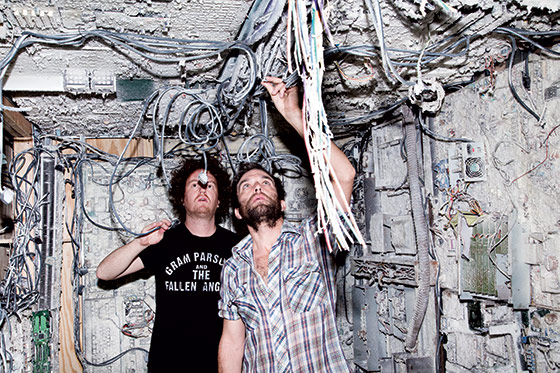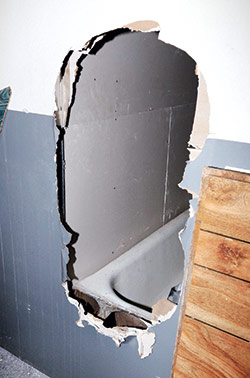
Despite everything that crystal meth and hallucinogens have done for their careers, Jonah Freeman and Justin Lowe are trying to kick their drug dependency. Installation artists who build intricate, disorienting warrens of junk-filled rooms that feel like deserted movie sets, they became well known in the crash years for their several squalid re-creations of meth labs—disturbingly fun dioramas of abjection. “It’s what everyone focused on,” says Lowe, 36. “Albeit it’s just one component.”
He’s not really complaining as he shows me around the busy build-out of street-level Marlborough Chelsea gallery on West 25th Street. There, he and Freeman are turning a big, gleaming space that could be a high-end auto-sales floor into a chopped-up hermetic underworld inspired by, among other things, the science fiction of William Gibson, J.G. Ballard, and Philip K. Dick; Cold War history; wandering around semi-gentrified Brooklyn and Los Angeles; and things they’ve seen on YouTube. There’s an alternate-universe version of an OTB parlor where the bets are taken on games involving fast food; a passageway inspired by the famously haphazard and since-torn-down Hong Kong city-slum-organism Kowloon Walled City; a room lined with salt-encrusted computer insides; a mahogany library full of renamed books; and what’s supposed to be a cheap outpatient plastic-surgery shop from a mall, some components of which came from a closed veterinary office. Most of the navigation is through holes smashed through the new drywall. It’s like exploring an instant ruin. “It’ll be like some horrible event had happened and everyone had to evacuate,” explains Freeman, 37, as he shows me a passageway behind a bathtub.
Back in 2006, Freeman and Lowe shared a 7,000-square-foot live-work space in East Williamsburg, almost in Bushwick—a then-underpopulated area of low industrial warehouses Freeman always thought would be a perfect place to stage a crime like a kidnapping. An NYU film graduate, Freeman grew up in Maine with his parents, who owned an organic farm and sent him away to an arty school. His mother is an astrologer (which is often referenced in their work). Unlike most of his fellow film students, he says he never had Hollywood ambitions, and he became friends with Lowe while looking for places to shoot his experimental movie about a city of 2 million tucked inside a building. Lowe, who was born in Ohio and whose half-brothers are the Hollywood actors Rob and Chad Lowe, was just finishing his M.F.A. at Columbia. One of his works was a teenage hideaway with the entrance through an old van. Later he turned a gallery into a bodega that connected to an ice-cream truck.
When an artist friend of theirs got back from Marfa, Texas (home to Donald Judd’s museum to himself), he suggested that Freeman and Lowe concoct a proposal together for one of the smaller exhibition spaces there, Ballroom Marfa. Working with their then–studio mate Alexandre Singh, they cooked up the craziest idea they could think of: a group of mysteriously abandoned rooms centering on two realistically untidy meth labs, one of which had apparently accidentally blown up.
Hello Meth Lab in the Sun was an instant hit: They had a hoarder’s story to tell about the history of drugs in America. It was also undeniably badass. Plus, coincidentally, it opened just after Breaking Bad came on, so meth was in the air.
“And still afterward, I didn’t think that we’d have a chance to do that again,” says Lowe. “Much less again and again and again.” Singh went off to do solo work, and “for the last three years, it’s been a real buddy flick,” says Lowe.
Later in 2008, Freeman and Lowe installed a more refined version in a Miami condominium that was used as temporary exhibition space during the Art Basel fair, renaming it Hello Meth Lab With a View. Jeffrey Deitch, the L.A. MoCA director who then was still running his deftly attention-seeking gallery in New York, saw it and had them do another version, this one called Black Acid Co-op. That was in 2009.
Next was Bright White Underground, which imagined an even more elaborate backstory. Set in a well-known modernist house in L.A., it was presented as the abandoned, clues-filled home of one Dr. Arthur Cook, a Timothy Leary–ish character who studied a psychedelic drug they named Marasa, after a set of sacred twins in voodoo practice. (As it turns out, the house was owned by one of their friends’ parents. “Her dad came when it was not quite done, and it looked like the set for Sanford and Son. This fucked-up junkyard,” says Lowe. “He said, ‘You know I’m a psychiatrist. And I deal with people who have issues of loss and mistrust. And I feel like I’ve lost my home, and I mistrust you.’ ”)

Another person who saw Meth Lab Miami and couldn’t get it out of his head was a college student named Max Levai, who was considering joining his family business—his father, Pierre Levai, runs Marlborough, which is known for its roster of not-so-edgy heavyweights like Fernando Botero, Dale Chihuly, and Tom Otterness. Pierre agreed to hand the Chelsea operation to Max, so he could stock it with new young artists. This show, Stray Light Grey (a Gibson reference), officially kicks off the new program.
“You have a kind of tabula rasa situation but one which is very well funded,” Lowe says of the Chelsea arrangement. Levai says he wants to “make a business out of the situation,” selling entire rooms or pieces from the rooms, or sculptures inspired by the installations, like cast-metal cactuses encrusted in crystals. Another goal is to make the installations “collapsible and make them fit into a shipping container, so you discard as little as possible.”
But just because there’s no meth lab this time doesn’t mean it’s not a drug experience, they tell me. “It’s really hard to see past the initial drug thing,” says Lowe. “It isn’t actually part of this installation, really, right?” He looks to Freeman, who agrees that it’s not “in an explicit way.”
“I mean, these things are always steeped in the pharmacopoeia. It’s become so pervasive that everyone’s on it,” says Lowe, who is obsessed with the secret history of CIA experimentations with LSD. “There’s this Brian Aldiss book Barefoot in the Head that imagines a postwar Europe where hallucinogens were weaponized. The entire culture is just constantly tripping.”